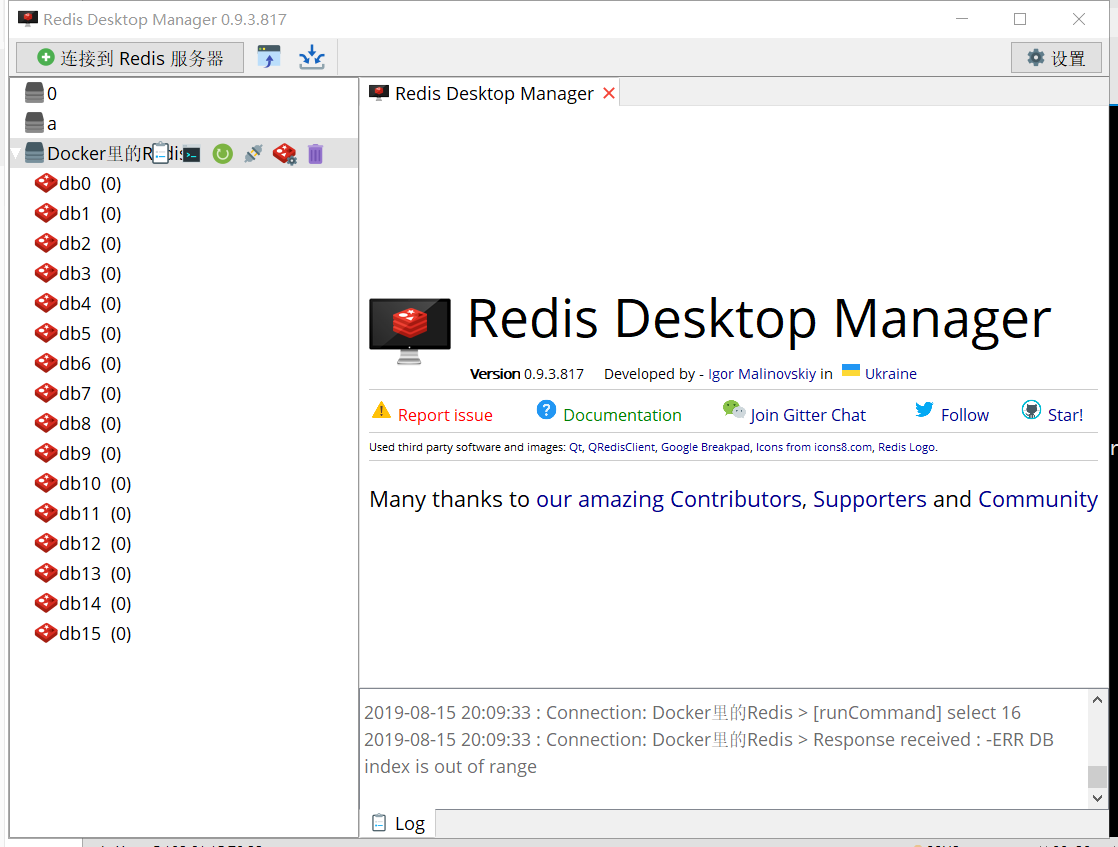ASP.NET Core Implements Distributed Caching Using Redis: Docker, IDistributedCache, StackExchangeRedis
Prerequisite: A Linux server with Docker installed.
I. Running Redis in Docker
Pull Redis image
docker pull redis
Query image list
docker images
Several methods to run Redis
- Run and set Redis port
docker run -p 6379:6379 -d redis:latest redis-server
docker run -p 6379:6379 -d {image_id} redis-server
- Persistence
Persist Redis data from Docker to the host machine
docker run -p 6379:6379 -v {host_path}:/data -d redis:latest redis-server --appendonly yes
Download Windows version of Redis Desktop Manager
Download link for Windows version of Redis Desktop Manager 64-bit 2019.1 (Chinese version): https://www.7down.com/soft/233274.html
Official latest version download link: https://redisdesktop.com/download
Also attached Redis learning tutorials:
Redis Chinese website: https://www.redis.net.cn/
.NET using Redis learning link (this tutorial version seems outdated): https://www.cnblogs.com/cang12138/p/8884362.html
Setting up a Master/Slave mode Redis cluster: https://blog.csdn.net/lupengfei1009/article/details/88323561#_154
Use Redis Desktop Manager to connect to Redis

II. ASP.NET Core Using Distributed Caching
In ASP.NET Core, support for caching using various databases is provided, with a unified interface for developers.
IDistributedCache
In ASP.NET Core, IDistributedCache provides a unified caching interface for developers, without having to focus on which database is used.
The IDistributedCache interface provides the following methods to perform operations on cached items in a distributed cache implementation:
- GetAsync – Accepts a string key and retrieves the cached item as a
byte[]array if found in the cache. - SetAsync – Adds an item (as a
byte[]array) to the cache using a string key. - RefreshAsync – Refreshes the cache based on its key, resetting its sliding expiration timeout (if any) for the item.
- RemoveAsync – Removes a cached item based on its string key.
Common methods provided by IDistributedCache are as follows:
| Method | Description |
| -------------------------------------------------------------- | ------------------------------------------------------------ |
| Get(String) | Retrieves the value for the specified key |
| GetAsync(String, CancellationToken) | Asynchronously retrieves the value for the specified key |
| Refresh(String) | Refreshes the cache |
| RefreshAsync(String, CancellationToken) | Refreshes a value in the cache based on its key, resetting its sliding expiration timeout (if any). |
| Remove(String) | Removes a specified value |
| RemoveAsync(String, CancellationToken) | Removes the value with the given key |
| Set(String, Byte[], DistributedCacheEntryOptions) | Sets a value with the given key |
| SetAsync(String, Byte[], DistributedCacheEntryOptions, CancellationToken) | Sets the value with the given key |
The official documentation is very detailed: https://docs.microsoft.com/zh-cn/dotnet/api/microsoft.extensions.caching.distributed.idistributedcache?view=aspnetcore-2.2
Configuring Caching in ASP.NET Core
Create a new ASP.NET Core WebApi project.
Install via Nuget Package Manager
Microsoft.Extensions.Caching.StackExchangeRedis
Use the service in ConfigureServices
services.AddDistributedMemoryCache();
Configure the Redis server
services.AddStackExchangeRedisCache(options =>
{
options.Configuration = "localhost:6379";
options.InstanceName = "mvc";
});
InstanceName is your custom instance name that will prefix the cache when created.
The configuration is now complete.
Using Caching
Modify the default generated ValuesController.cs.
Inject the caching service
private readonly IDistributedCache _cache;
public ValuesController(IDistributedCache cache)
{
_cache = cache;
}
Set and use the cache:
await _cache.GetAsync("{key_name}");
_cache.SetAsync("{key_name}", {value}, {options});
Remove the original methods and add the following code:
[HttpGet("Set")]
public async Task<JsonResult> SetCache(string setkey, string setvalue)
{
string key = "key1";
if (!string.IsNullOrEmpty(setkey))
key = setkey;
string value = DateTime.Now.ToLongTimeString();
if (!string.IsNullOrEmpty(setvalue))
value = setvalue;
await _cache.SetStringAsync(key, value);
return new JsonResult(new { Code = 200, Message = "Cache set successfully", Data = "key=" + key + " value=" + value });
}
[HttpGet("Get")]
public async Task<JsonResult> GetCache(string setkey)
{
string key = "key1";
if (!string.IsNullOrEmpty(setkey))
key = setkey;
var value = await _cache.GetStringAsync(key);
return new JsonResult(new { Code = 200, Message = "Cache retrieved successfully", Data = "key=" + key + " value=" + value });
}
Add QueryString to URL to set cache content; if no parameters are provided, the default values will be used.
Open https://localhost:5001/api/values/set to see the default values set.
Alternatively, visit https://localhost:5001/api/values/set?setkey=key11111&setvalue=asafesfdsreg to customize the cached value.

Open https://localhost:5001/api/values/get?setkey=key11111 to retrieve the cached value.
Setting Cache Expiration Time
Use DistributedCacheEntryOptions to set cache expiration time.
DistributedCacheEntryOptions has three properties for relative time and absolute time.
Usage
[HttpGet("Set")]
public async Task<JsonResult> SetCache(string setkey, string setvalue)
{
string key = "key1";
if (!string.IsNullOrEmpty(setkey))
key = setkey;
string value = DateTime.Now.ToLongTimeString();
if (!string.IsNullOrEmpty(setvalue))
value = setvalue;
var options = new DistributedCacheEntryOptions()
.SetSlidingExpiration(TimeSpan.FromSeconds(20));
await _cache.SetStringAsync(key, value, options);
return new JsonResult(new { Code = 200, Message = "Cache set successfully", Data = "key=" + key + " value=" + value });
}
The cache will expire after 20 seconds; this cache will be cleared after 20 seconds.

文章评论